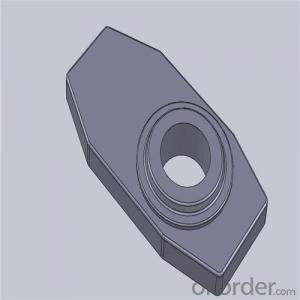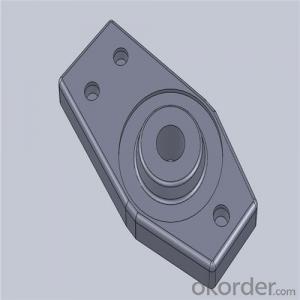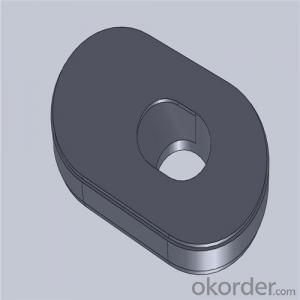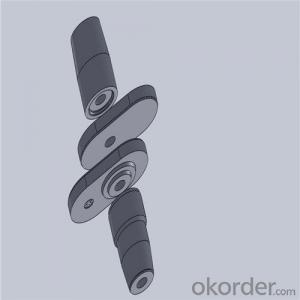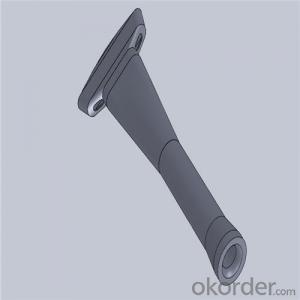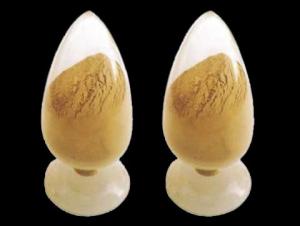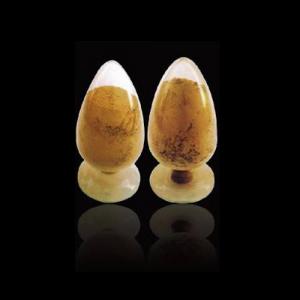High Performance&Temperature Ladle Sliding Gate for Steel
- Loading Port:
- Shanghai
- Payment Terms:
- TT OR LC
- Min Order Qty:
- 100 pc
- Supply Capability:
- 1000 pc/month
OKorder Service Pledge
OKorder Financial Service
You Might Also Like
Quick Details for High Performance Refractory Ladle Slide Gate
| Place of Origin: | China (Mainland) | Shape: | Plate | Material: | Alumina Block |
| SiO2 Content (%): | N/A | Al2O3 Content (%): | 80-90% | MgO Content (%): | N/A |
| CaO Content (%): | N/A | Refractoriness (Degree): | 1770°< Refractoriness< 2000° | CrO Content (%): | N/A |
| SiC Content (%): | N/A | Model Number: | CS80 | Brand Name: | |
| Product name: | High performance refractory ladle slide gate | Model No.: | cs80 | Brand name: | CMAX |
| Quality: | Al-C or Al-Zr-C | Service life: | 4-6 heats | Apparent porosity: | 7% Max |
| Bulk density:: | 3.1 MIN | C.C.S: | 120MPA | MOQ: | 100 pcs for trial |
| Delivery time: | 60 working days upon receipt of deposit |
Packaging & Delivery
| Packaging Details: | Inner carton packing, outer wooden case suitable for long term sea shipping |
| Delivery Detail: | three months working days upon receipt of deposit |
Specifications
Surface flatness less than 0.05mm
High mechanical strength
Erosion resistance
Oxidation resistance
Thermal shock stability
Using the raw materials of tabular alumina, zirconia-corundum, carbon and other high-grade additives, after sintering to obtain characteristics of oxidation resistance, scour strength, erosion resistance, thermal shock resistance, shape stable and long service life, made our products the preferred materials for the large and medium-sized steel ladle, refining ladle, series of alloy steel ladle, and tundish. Our high performance sintering sliding gates include alumina carbon , Al2O3-ZrO2-C, etc, can meet the needs of different steel grade.
General Chemical Analysis for refractory ladle slide gate :
slide gate plate widely including Alumina carbon and Alumina Zirconia Carbon slide gate plate, MgO and MgO-spinel slide gate plate,nonoxides bonding slide gate plateand unburned slide gate plate.
Alumina -Zirconia-Carbon material
| Al-Zr-C Material | |||||
| Al2O3 | C | ZrO2 | Apparent porosity | Bulk density | C.C.S |
| (% minm) | (% minm) | (% minm) | (% max) | (gm./cc minm) | (MPa minm) |
| 85 | 3 | 5 | 7 | 3.1 | 120 |
| 85 | 3 | 4 | 7 | 3.1 | 120 |
Composite type: Al-Zr-C for working line, outer Al-C material
| Al-Zr-C & Al-C Material | ||||||
| Al2O3 | C | ZrO2 | Apparent porosity | Bulk density | C.C.S | |
| (% minm) | (% minm) | (% minm) | (% max) | (gm./cc minm) | (MPa minm) | |
| Inner side (Working face) | 85 | 3 | 4 | 7 | 3.1 | 120 |
| Outside | 90 | 3 | 0 | 9 | 3 | |

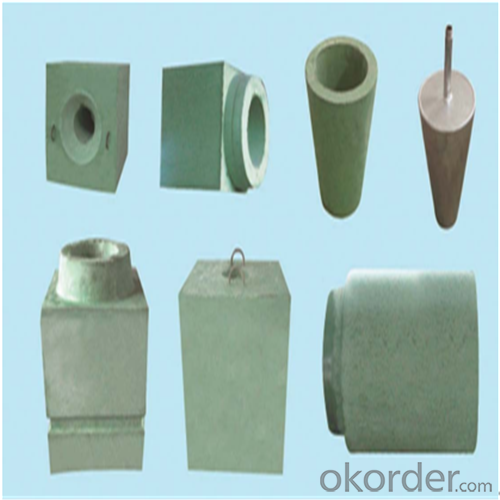
Other Products
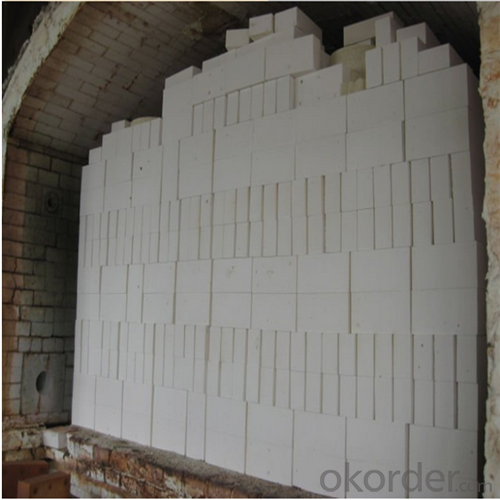
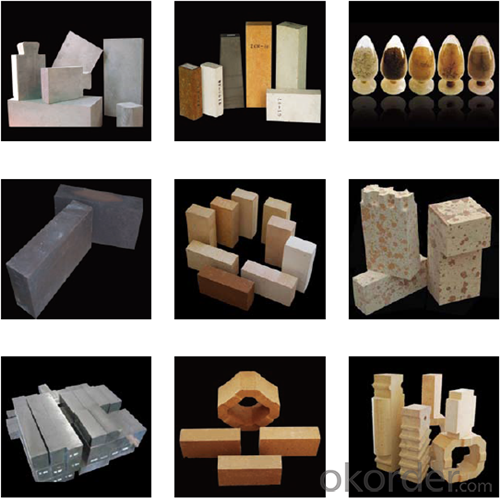
About us

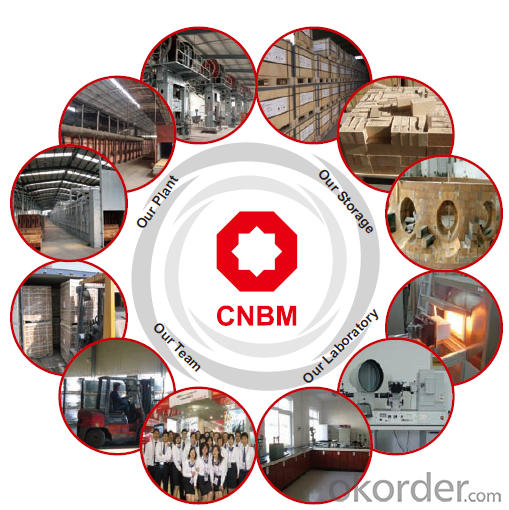
Sample is on your request.
Welcome to visit our factory~
- Q:How do monolithic refractories contribute to the overall efficiency of steel ladle operations?
- Monolithic refractories play a crucial role in enhancing the overall efficiency of steel ladle operations. These refractories are engineered materials that are installed as a single, unbroken structure within the ladle. They offer numerous benefits that directly contribute to the efficiency of the steel ladle operations. Firstly, monolithic refractories are known for their excellent thermal insulation properties. They have low thermal conductivity, which means they can effectively retain and contain heat within the ladle. This insulation property helps in maintaining the desired temperature of the molten steel, preventing heat loss during transportation and reducing the need for frequent reheating. By minimizing heat loss, monolithic refractories enable more efficient use of energy resources, resulting in cost savings and improved productivity. Additionally, monolithic refractories exhibit high refractoriness, which refers to their ability to withstand high temperatures without losing their structural integrity. This characteristic is vital in steel ladle operations, as the ladles are exposed to extreme temperatures during the steelmaking process. The high refractoriness of monolithic refractories ensures that they can withstand the intense heat and prevent any damage or failure of the ladle lining. This durability translates into reduced downtime and maintenance requirements, leading to increased operational efficiency. Moreover, monolithic refractories offer excellent resistance to chemical attack. The ladles used in steelmaking are in contact with various corrosive substances, such as molten metals, slag, and fluxes. The chemical resistance of monolithic refractories prevents them from reacting with these substances, ensuring the integrity and longevity of the ladle lining. This resistance to chemical attack reduces the frequency of repairs and replacements, minimizing downtime and improving the overall efficiency of ladle operations. Furthermore, the installation of monolithic refractories is relatively quick and straightforward compared to traditional brick linings. This ease of installation saves time and labor costs, allowing for faster turnaround between ladle operations. It enables steel manufacturers to optimize their production schedules and enhance overall operational efficiency. In conclusion, monolithic refractories contribute significantly to the overall efficiency of steel ladle operations. Their excellent thermal insulation properties, high refractoriness, resistance to chemical attack, and ease of installation all play vital roles in improving energy efficiency, reducing downtime, and enhancing productivity. By choosing monolithic refractories, steel manufacturers can achieve optimized ladle performance and ultimately improve their overall steelmaking process.
- Q:What are monolithic refractories and how are they different from other refractory materials?
- Monolithic refractories, unlike bricks or tiles, are refractory materials that are not pre-formed into specific shapes or sizes. Instead, they are composed of a mixture of aggregates, binders, and additives, which are then installed and cured to create a solid and dense structure. One notable difference between monolithic refractories and other refractory materials is their versatility and ease of installation. While traditional bricks or tiles require skilled labor and careful assembly, monolithic refractories can be poured, sprayed, or gunned into place, allowing for a faster and more efficient installation process. This makes them particularly suitable for complex shapes or hard-to-reach areas. Another distinction lies in the physical properties of monolithic refractories. Unlike bricks and tiles, which are known for their mechanical strength and resistance to thermal shock, monolithic refractories can be customized to exhibit a wide range of properties. Depending on the specific application requirements, they can be engineered to have excellent thermal insulation, superior corrosion resistance, or enhanced abrasion resistance. This adaptability makes monolithic refractories suitable for various industries, including steel, cement, glass, and petrochemical. Furthermore, monolithic refractories have the advantage of being able to expand and contract with temperature changes, unlike rigid brick structures. This thermal flexibility helps prevent cracking and damage caused by thermal cycling, thus prolonging the lifespan of the refractory lining. Additionally, monolithic refractories offer better refractory integrity and reduced joint failure since they do not have seams or weak points that are susceptible to thermal stresses. In conclusion, monolithic refractories are a versatile and convenient type of refractory material that can be tailored to meet specific application requirements. Their easy installation, thermal flexibility, and customizable properties distinguish them from other refractory materials like bricks or tiles.
- Q:What are the quality control measures for monolithic refractories in the iron and steel industry?
- The quality control measures for monolithic refractories in the iron and steel industry include strict material selection, thorough testing of raw materials, regular inspection and maintenance of refractory linings, and continuous monitoring of performance during operation. Additionally, adherence to industry standards and specifications, implementation of quality management systems, and collaboration with suppliers and customers to address any quality issues are also important measures in ensuring the quality of monolithic refractories in the iron and steel industry.
- Q:How do monolithic refractories withstand chemical attack from molten metals and slag?
- Monolithic refractories withstand chemical attack from molten metals and slag due to their unique composition and properties. These refractories are made of a single, homogeneous material, which provides them with better resistance against chemical corrosion. Additionally, monolithic refractories are designed to have low porosity and high density, which limits the penetration of molten metals and slag into their structure. These materials also have high melting points, enabling them to withstand the extreme temperatures present in industrial processes. Overall, the combination of their composition, low porosity, high density, and high melting points makes monolithic refractories highly resistant to chemical attack from molten metals and slag.
- Q:How do monolithic refractories resist abrasion in the iron and steel industry?
- Monolithic refractories, with their unique composition and properties, are specifically designed for the iron and steel industry to resist abrasion. Made from a single homogeneous material, they exhibit exceptional strength and durability when subjected to continuous abrasion. The high density of monolithic refractories is one of the key factors contributing to their abrasion resistance. These refractories are manufactured with tightly packed particles, resulting in a solid and compact structure. This density minimizes wear and tear caused by the constant movement of materials like iron and steel. Furthermore, monolithic refractories often contain high levels of alumina, known for its excellent resistance to abrasion. Alumina is a highly refractory material that can withstand high temperatures and mechanical stress without deteriorating. Its presence in monolithic refractories creates a protective layer that resists abrasion caused by the movement and impact of iron and steel particles. In addition, monolithic refractories can be designed with specific additives and binders that further enhance their resistance to abrasion. These additives may include silicon carbide, mullite, or zirconia, which are renowned for their superior mechanical strength and ability to withstand wear. The binders used in the manufacturing process also contribute to the refractory's integrity and its ability to resist abrasion by providing a cohesive structure. In conclusion, the combination of high density, alumina content, specialized additives, and binders makes monolithic refractories highly resistant to abrasion in the iron and steel industry. They can withstand the harsh conditions and constant movement of materials, ensuring long-lasting performance and efficiency in various applications within the industry.
- Q:What are the specific requirements of monolithic refractories for steel ladle purging applications?
- To ensure optimal performance and durability, monolithic refractories used in steel ladle purging applications must meet certain requirements. Firstly, they need to possess high thermal stability and resistance to thermal shock, as the steelmaking process involves extreme temperatures. This is crucial in order to prevent any cracking or spalling of the refractory lining. Additionally, monolithic refractories used for ladle purging applications should exhibit excellent corrosion resistance against molten steel and slag. They must be able to withstand the aggressive chemical environment without experiencing significant deterioration, as this could lead to contamination of the steel and negatively impact its quality. Another essential requirement is good erosion resistance. The refractories should be capable of withstanding the high velocity of the purging process, which involves the injection of argon or other gases into the ladle to remove impurities. This erosion resistance ensures that the refractory lining remains intact and does not wear away during operation. Furthermore, monolithic refractories for ladle purging applications should have low porosity and high density. This prevents the infiltration of molten steel and slag into the refractory lining, thus reducing the risk of thermal spalling and corrosion. Lastly, these refractories should exhibit good thermal conductivity in order to efficiently transfer heat from the steel to the refractory lining. This allows for better temperature control and energy efficiency during the purging process. Overall, the specific requirements for monolithic refractories in steel ladle purging applications include high thermal stability, corrosion resistance, erosion resistance, low porosity, high density, and good thermal conductivity. Meeting these requirements ensures that the refractories can withstand the harsh conditions of the steelmaking process, maintain their integrity, and contribute to the production of high-quality steel.
- Q:What are the factors affecting the lifespan of monolithic refractories?
- There are several factors that can significantly affect the lifespan of monolithic refractories. 1. Temperature: One of the most critical factors is the operating temperature. Monolithic refractories are designed to withstand high temperatures, but prolonged exposure to extreme temperatures can cause thermal shock and lead to premature failure. 2. Thermal cycling: Frequent temperature fluctuations, known as thermal cycling, can also shorten the lifespan of monolithic refractories. The expansion and contraction of the refractory material can create stress, resulting in cracking and degradation over time. 3. Chemical environment: The chemical environment in which the monolithic refractories are used plays a crucial role in their lifespan. Exposure to corrosive gases, acids, alkalis, or molten metals can cause chemical reactions that degrade the refractory material. 4. Mechanical stress: Mechanical stress, such as abrasion, impact, and vibration, can weaken monolithic refractories and shorten their lifespan. This is especially relevant in industries with high mechanical activity, such as steelmaking or cement production. 5. Installation and maintenance: Proper installation and regular maintenance are essential for maximizing the lifespan of monolithic refractories. Poor installation techniques or neglecting maintenance can result in weak joints, inadequate anchoring, or the growth of cracks, leading to premature failure. 6. Quality of refractory material: The quality and composition of the monolithic refractory material can significantly impact its lifespan. Higher-quality materials with better resistance to temperature, chemical attacks, and mechanical stress tend to have longer lifespans. 7. Design and engineering: The design of the refractory lining and its engineering considerations, such as thickness, shape, and reinforcement, also influence the lifespan of monolithic refractories. Proper design can distribute stress more evenly, reduce thermal gradients, and improve overall performance and durability. 8. Operating conditions: The way monolithic refractories are operated and handled can affect their lifespan. Factors such as rapid temperature changes, improper cooling or heating procedures, or excessive thermal cycling can all contribute to premature failure. In summary, the lifespan of monolithic refractories is influenced by various factors, including temperature, thermal cycling, chemical environment, mechanical stress, installation and maintenance practices, quality of refractory material, design and engineering considerations, and operating conditions. Proper consideration and management of these factors are essential for maximizing the lifespan of monolithic refractories.
- Q:What are the main types of monolithic refractories used in the iron and steel industry?
- The main types of monolithic refractories used in the iron and steel industry are castables, ramming materials, gunning materials, and plastic refractories. Castables are a type of refractory material that can be poured or cast into various shapes and sizes. They are made from a mixture of refractory aggregates, binders, and additives. Castables are commonly used in areas such as ladles, tundishes, and blast furnaces due to their excellent thermal shock resistance and high strength. Ramming materials, also known as ramming mixes, are used for lining the bottoms of furnaces and other high-temperature applications. They are typically composed of refractory aggregates and a bonding agent, which allows them to be compacted or rammed into place. Ramming materials offer good resistance to thermal cycling and can withstand high temperatures. Gunning materials are designed to be sprayed or gunned onto the refractory surface using a high-pressure gunning machine. They are used for repairing and patching refractory linings that have been damaged or eroded. Gunning materials are usually made from a mixture of refractory aggregates, binders, and additives. They provide excellent adhesion and are commonly used in applications such as kilns, converters, and electric arc furnaces. Plastic refractories are a type of monolithic refractory that can be molded or formed into various shapes. They are made from a mixture of refractory aggregates, plasticizers, and binders. Plastic refractories are used for lining various equipment and structures in the iron and steel industry, including boilers, incinerators, and chimneys. They offer good resistance to thermal shock and can be easily installed by hand or with a trowel. Overall, these types of monolithic refractories play a crucial role in the iron and steel industry by providing high-temperature resistance, thermal insulation, and durability to the various equipment and structures used in the production process.
- Q:What are the challenges in repairing and maintaining monolithic refractories?
- There are several challenges associated with repairing and maintaining monolithic refractories. One major challenge is the complex nature of the materials used in monolithic refractories. These materials are often a combination of several components, including aggregates, binders, and additives. The selection and proportioning of these components can greatly impact the performance and durability of the refractory, making it difficult to determine the exact repair or maintenance method. Another challenge is the high temperatures at which monolithic refractories operate. These materials are designed to withstand extreme heat, which can range from several hundred to several thousand degrees Celsius. Repairing or maintaining monolithic refractories at such high temperatures requires specialized equipment and techniques to ensure the safety of the workers and the integrity of the repair. Additionally, monolithic refractories are often exposed to harsh environments, such as corrosive gases, chemical reactions, and mechanical stresses. These factors can lead to degradation and damage over time, requiring regular inspections and maintenance. Identifying and addressing these issues in a timely manner can be challenging, as the damage may not always be visible or easily accessible. Furthermore, monolithic refractories are commonly used in complex industrial processes, such as steelmaking, cement manufacturing, and petrochemical production. These processes often involve continuous operation, which limits the time available for repairs and maintenance. Finding suitable windows of opportunity for maintenance and coordinating the shutdowns of these processes can be a logistical challenge. Lastly, the cost of repairing and maintaining monolithic refractories can be significant. The materials used in monolithic refractories can be expensive, and the labor and equipment required for repairs and maintenance can add up. Balancing the cost of repairs with the need to maintain productivity and extend the service life of the refractories can be a challenge for plant operators and maintenance teams. In conclusion, the challenges in repairing and maintaining monolithic refractories stem from the complex nature of the materials, the high temperatures involved, the harsh operating environments, the complexity of industrial processes, and the cost considerations. Overcoming these challenges requires expertise, careful planning, and effective coordination to ensure the longevity and performance of monolithic refractories.
- Q:What are the advantages of using low-cement castables in the iron and steel industry?
- There are numerous benefits associated with the utilization of low-cement castables in the iron and steel sector. To begin with, low-cement castables necessitate less water compared to traditional castables. Consequently, the installation process becomes faster and more efficient due to the reduced water requirement. Moreover, the lower water content results in enhanced strength development and shorter drying time, facilitating faster turnaround times during production. In addition, low-cement castables exhibit exceptional resistance to extreme temperatures and thermal shocks. Given the high temperatures prevalent in the iron and steel industry, these castables possess excellent refractory properties that enable them to withstand such harsh conditions. Consequently, the refractory lining enjoys an extended service life, reducing the need for frequent repairs or replacements. Furthermore, low-cement castables demonstrate remarkable mechanical strength and abrasion resistance. Given the nature of the iron and steel sector, where heavy materials and abrasive substances are handled, the refractory lining is susceptible to wear and tear. However, low-cement castables are capable of enduring these mechanical stresses, thereby enhancing the durability and longevity of the lining. Moreover, low-cement castables possess low porosity and high density, resulting in reduced permeability. Consequently, they exhibit high resistance to alkali attacks, chemical corrosion, and slag penetration, all of which are common challenges faced in the iron and steel industry. By employing low-cement castables, the risk of refractory failure caused by these corrosive elements is minimized. Lastly, low-cement castables contribute to improved energy efficiency. Their lower thermal conductivity ensures that less heat is conducted through the refractory lining, leading to reduced heat losses. This, in turn, translates into energy savings, as less heat is wasted and more heat is retained within the system. The significance of this advantage is particularly evident in the iron and steel industry, where energy costs can be substantial. In conclusion, the use of low-cement castables in the iron and steel sector offers a multitude of advantages, including reduced water requirement, superior thermal resistance, enhanced mechanical strength, improved resistance to chemical corrosion, and increased energy efficiency. These benefits contribute to overall cost savings, heightened productivity, and improved operational performance in the iron and steel manufacturing process.
1. Manufacturer Overview |
|
|---|---|
| Location | |
| Year Established | |
| Annual Output Value | |
| Main Markets | |
| Company Certifications | |
2. Manufacturer Certificates |
|
|---|---|
| a) Certification Name | |
| Range | |
| Reference | |
| Validity Period | |
3. Manufacturer Capability |
|
|---|---|
| a)Trade Capacity | |
| Nearest Port | |
| Export Percentage | |
| No.of Employees in Trade Department | |
| Language Spoken: | |
| b)Factory Information | |
| Factory Size: | |
| No. of Production Lines | |
| Contract Manufacturing | |
| Product Price Range | |
Send your message to us
High Performance&Temperature Ladle Sliding Gate for Steel
- Loading Port:
- Shanghai
- Payment Terms:
- TT OR LC
- Min Order Qty:
- 100 pc
- Supply Capability:
- 1000 pc/month
OKorder Service Pledge
OKorder Financial Service
Similar products
New products
Hot products
Related keywords
